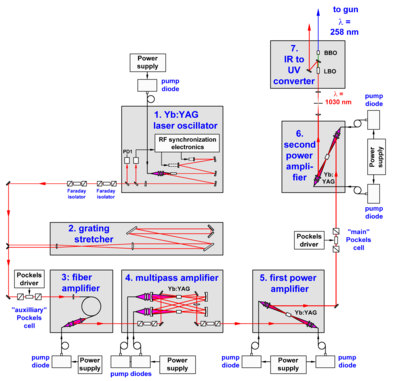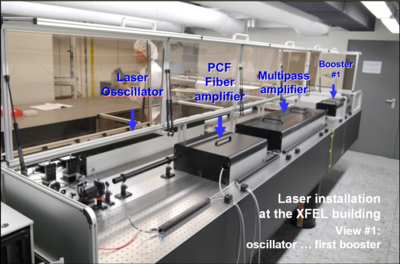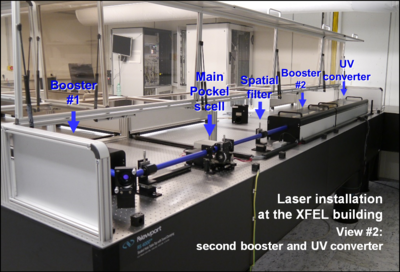4.1 Implementation of Lasers and Measuring Techniques
Project coordinators: I. Will , F. Furch , M. van Moerbeck-BockT1: Laser systems for accelerators
Ingo Will
An important part of the project is devoted to the development of picosecond lasers systems at very high average power, both in the burst-mode and the quasi-cw operation mode. One major application of these lasers is their use for pump-probe experiments at Free Electron Laser and synchrotron radiation sources.
Link to Laser for the MAXYMUS microscope
The second applications of these lasers arise from various collaborations with national and international high-energy accelerator and Free Electron Laser projects: MBI as an early member of the international TESLA Collaboration has provided the Photo injector drive lasers (also called simply "photocathode lasers") for the radio-frequency guns (RF guns) of various electron accelerators and Free Electron Lasers (FELs).
At present, the special lasers developed at the MBI drive the photo injectors of the linacs in the following laboratories of our cooperation partners:
- European XFEL at DESY Hamburg
- FLASH FEL at DESY Hamburg
- Photoinjector Test Facility at Zeuthen (PITZ)
- Superconducting RF gun being developed at the Helmholtzzentrum Dresden Rossendorf (HZDR) for the ELBE FEL
- Helmholtz-Zentrum für Materialien und Energie Berlin (HZB)
Drive laser for the European XFEL at DESY Hamburg
The MBI has been responsible for the development of the first laser driving the photo injector (RF gun) of the European XFEL since 1997.
The most advanced photocathode laser developed at MBI drives the photo injector of the European XFEL at Hamburg. This photocathode laser produces bursts of up 2700 pulses with a repetition rate of 10 Hz. The maximum repetition rate within the individual pulses within the burst amounts to 4.5 MHz.
The oscillator is passively mode locked by a SAM (Saturable Absorber Mirror). It generates pulses of ~4 ps duration with a 54.166 MHz repetition rate.
The variable grating pulse stretcher stretches the pulses to a duration of up to 20 ps FWHM.
The amplifier chain raises the energy of the picosecond pulses of Gaussian shape by more than four orders of magnitude. It includes four spatial filters, two Pockels cells with their drivers, two Faraday isolators, a fiber preamplifier, a multipass amplifier and two booster stages.
In order to preserve a stable beam profile during the pulse trains the last four amplifier stages have been connected by relay-imaging telescopes. This way the laser beam profile of each amplifier stage is successively enlarged and imaged into the following one. This aids in reducing the undesirable effect of thermally induced perturbation of the refraction index in the laser rods on the beam profile (thermal lensing). Due to the presence of pinholes in the foci of the lenses the telescopes, in addition, act as spatial filters and improve the quality of the amplified laser beam significantly.
The final de-magnifying telescopes adapts the power density of the infrared (IR) pulses from the laser system with 1030nm wavelength to the optimum level for efficient conversion to ultraviolet (UV) pulses a wavelength of 257 nm by the arrangement of an 8 mm long LBO, followed in close proximity by a 6 mm long BBO. The first crystals generates the second harmonics of the infrared laser radiation, the second one transfers this radiation to the ultraviolet (UV) pulses. A maximum efficiency of 16% is obtained.


